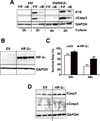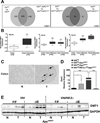Hypoxia-inducible factor-2α activation promotes colorectal cancer progression by dysregulating iron homeostasis
- PMID: 22419665
- PMCID: PMC3342485
- DOI: 10.1158/0008-5472.CAN-11-3836
Hypoxia-inducible factor-2α activation promotes colorectal cancer progression by dysregulating iron homeostasis
Abstract
Hypoxia-inducible factor (HIF), a key modulator of the transcriptional response to hypoxia, is increased in colon cancer. However, the role of HIF in colon carcinogenesis in vivo remains unclear. In this study, we found that intestinal epithelium-specific disruption of the von Hippel-Lindau tumor suppressor protein (VHL) resulted in constitutive HIF signaling, and increased HIF expression augmented colon tumorigenesis in the Apc(min/+) intestinal tumor model. Intestine-specific disruption of Vhl increased colon tumor multiplicity and progression from adenomas to carcinomas. These effects were ameliorated in mice with double disruption of Vhl and HIF-2α. Activation of HIF signaling resulted in increased cell survival in normal colon tissue; however, tumor apoptosis was not affected. Interestingly, a robust activation of cyclin D1 was observed in tumors of Apc(min/+) mice in which HIF-2α was activated in the intestine. Consistent with this result, bromodeoxyuridine incorporation indicated that cellular proliferation was increased in colon tumors following HIF activation. Further analysis showed that dysregulation of the intestinal iron absorption transporter divalent metal transporter-1 (DMT-1) was a critical event in HIF-2α-mediated colon carcinogenesis. These data provide a mechanistic basis for the widely reported link between iron accumulation and colon cancer risk. Together, our findings show that a chronic increase in HIF-2α in the colon initiates protumorigenic signaling, which may have important implications in developing preventive and therapeutic strategies for colon cancer.
©2012 AACR
Conflict of interest statement
Figures






References
-
- Hockel M, Vaupel P. Tumor hypoxia: definitions and current clinical, biologic, and molecular aspects. J Natl Cancer Inst. 2001;93:266–276. - PubMed
-
- Wang GL, Semenza GL. Characterization of hypoxia-inducible factor 1 and regulation of DNA binding activity by hypoxia. J Biol Chem. 1993;268:21513–21518. - PubMed
Publication types
MeSH terms
Substances
Grants and funding
LinkOut - more resources
Full Text Sources
Other Literature Sources
Medical
Molecular Biology Databases
Research Materials

